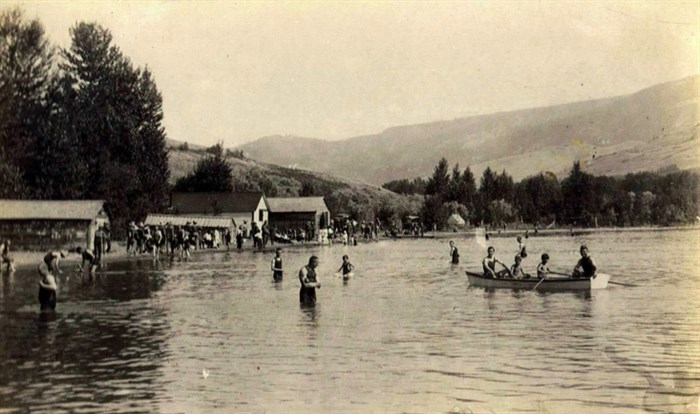
Long (Kalamalka) Lake beach in the early 1900s.
Image Credit: FACEBOOK/Old Kelowna
January 08, 2023 - 9:00 AM
When Europeans explored, then settled, much of North America they ignored the names given to creeks and lakes by the First Nation inhabitants.
That’s not always the case but, where First Nations names endured in the Okanagan, they were generally mispronounced to fit European preferences.
Over time, those early settlers gave way to new generations and new immigrants and the origins of the names they gave our towns and villages faded.
In 1948, the 12th edition of the Okanagan Historical Society did its best to retain that knowledge by publishing an extensive list of the names of creeks, lakes and towns and where they came from.
Some are well known, such as Kelowna being named after a grizzly bear and Oyama bearing the name of a Japanese warlord.
But, not too many people know that Kelowna was initially called “Nor-kwa-stin,” referring to the hard black rock that was used for sharpening flints.
The “grizzly bear” moniker actually refers to a “husky, hairy Frenchman” who lived in a half-underground hovel and was called “kimach touche” by First Nation peoples, meaning “brown bear” or “bear face.”
That was too much of a mouthful for white folk who took, instead, the First Nation word for grizzly bear: Kelowna.

Bernard Avenue in Kelowna with the Lequme store in 1901.
Image Credit: FACEBOOK/Old Kelowna
Even the meaning of the region’s name – Okanagan – is unclear. One version is it meant a rendezvous area for First Nations, anther that it meant “big head” that refers to a chosen people.
The original European spelling has gone through 46 different spellings, starting with Lewis and Clark, in 1805, who spelled it Otchen-aukane.
The Okunaaka version, used in the headline above, was used in 1813 when the Pacific Fur Company was changed to the North West Company.
Even today, there are two different spellings for Okanagan with the American version being Okanogan.
"There’s a number of sounds in nsyilxcen that don’t actually exist in English, so it’s not possible to spell them correctly in English," Michele Johnson, executive director of the Syilx Language House Association told iNFOnews.ca. "I don't think they (Europeans) intentionally misspelled the words. I think they intentionally didn't learn the language."
Similarly, they used European words to name place and ignored the First Nations names.
"They were colonizing so they didn't have to learn the very complex language that was pre-existing here," Johnson said.
On the spiritual side, Naramata’s name was drawn from the spirits and referred to a First Nations woman named Narramattah. Of course it, too, was simplified to fit white tastes. It may also have derived from aboriginal languages in Australia.
The 1948 report on place names, written by A.J. Harvey, cites dozens of sources but, key among them, is the Geographic Board of Canada. Sources also go back to the 1811 trip through the region by David Thompson and even Lewis and Clark in 1805.
Most of the names in the region arose during the period of settlement from 1880-1910 but new ones, like Lake Country and West Kelowna, are still emerging.
Here is a partial list of the names chronicalled in the 1948 edition of the Okanagan Historical Society.
The full list can be seen here, starting on page 195 of the index.
Anarchist Mountain
Richard G. Sidley, a justice of the peace and customs officer, settled nearby in 1889. An Irishman of "advanced political views," he was often called an anarchist and was relieved of his government posts, hence the mountain’s name.
Armstrong
Named in 1892 after Hector Armstrong who negotiated the bonds of the Shuswap and Okanagan Railway, which opened on July 1, 1892.
Bear Creek
This was originally called Bear River but was changed by the Geographic Board of Canada in 1922 to Lambly Creek, as it still exists on some maps. It was named for Charles Anderson Richardson Lambly who pre-empted land near Peachland and had been a government agent in Rock Creek and Osoyoos.
Belgo Creek
The Belgo Canadian Fruit Lands Co. incorporated in 1909 and built a dam there to conserve water for irrigation.
Bellevue Creek
Named after the Bellevue Hotel, built near the mouth of the creek by Gifford Thomson in the 1900s.
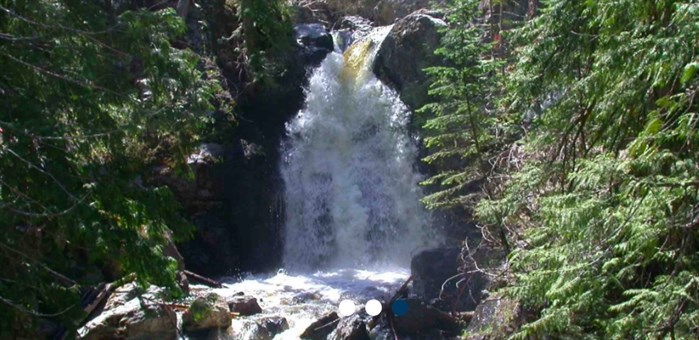
Bellevue Creek in Kelowna.
Image Credit: Submitted/City of Kelowna
Benvoulin
The name of the Scottish home of George Grant MacKay, civil engineer and early investor in Vancouver and Okanagan real estate. He bought land there in 1891. He was the agent for Lord Aberdeen when he bought the Coldstream Ranch. His company built the Kalamalka Hotel in Vernon.
Mount Boucherie
Named after settler Isador Boucherie around 1888.
BX Creek
The B.X. (Barnard’s Express) Ranch was established by Francis Jones Barnard east of Swan Lake about 1868 to supplying horses to the B.X. stage lines.
Caesars Landing
After Henry Caesar, the first settler there in 1893. He built a small steam launch, the Wanderer. It was 39 yards, two feet long, used a five horsepower engine and was the first steamboat on Okanagan Lake. “With this boat we hauled booms of logs to the saw mill at Kelowna, ore from Morning Glory Mine to the mill near Okanagan Landing, dynamite to Penticton as the S.S. Aberdeen was not allowed to carry it with passengers . . . cricket teams to Trout Creek and Okanagan Landing.”
Cawston
Named after Richard Lowe Cawston who moved there in 1874 after managing the Lowe and Haynes Cattle ranch at Osoyoos. He vaccinated First Nations people en masse during a smallpox epidemic.
Cherryville
Formerly Camagna after a 1909 postmaster. The post office closed in 1919 and reopened as Cherryville that same year.
Chute Lake
Formerly Lequime Lake. Chute is French for fall or fast water. The Chute Lake post office opened in 1921 and closed two years later.
Coldstream Creek
Colonel Charles Frederick Houghton pre-empted land along the creek in 1863. In 1869 the land was partitioned. He took a parcel near the head of Okanagan Lake and gave up the “Coldstream Farm.” An 1871 map shows it as ‘Houghton’s Coldstream.” The Corporation of the District of Coldstream was incorporated on Dec. 21, 1906.
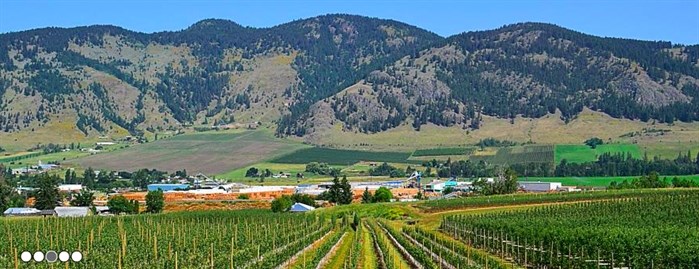
Coldstream
Image Credit: Submitted/District of Coldstream
Commonage
The area between Long (Kalamalka) and Okanagan Lakes was withdrawn from pre-emption or purchase and reserved for pasturage for First Nations and whites in common (hence the name) in 1876. In 1889, the Dominion government offered to relinquish First Nation rights to Okanagan pasture lands if the Province would sanction establishment of an Indian Reserve on the west side of Okanagan Lake. The province agreed and, in 1892, subdivided the Commonage and offered it for sale by auction in 1893.
Cosens Bay
On the east side of Long (Kalamalka) Lake, named after Cornelius Cosens who settled there in 1893.
READ MORE: IN PHOTOS: Here’s why there’s a never-ending war over the road in Kalamalka Lake park
Ellison (Duck) Lake
Named after Price Ellison who was a stock raiser and wheat grower. He served as an MLA from 1898-1916 where he spent a year as Minister of Finance and Agriculture.
Enderby
Originally Spallumcheen then Lambly’s Landing after brothers Thomas McKie Lambly and Robert Lambly who had a freight warehouse. At an afternoon tea in 1887, when the Spallumcheen (now Shuswap) River was overflowing its banks, Mrs. Henry Oliver recited Jean Inelow’s poem, ‘The High Tide on the Coast of Lincolnshire” that contained the lines: “Ply all your changes, all your swells, Play uppe (sic) the Brides of Enderby.” The lilt of the poem and the name Enderby so pleased the women that they proposed it as the name for the town. It was approved by the Dominion government and the post office opened on Nov. 1, 1887. It was incorporated as a city on March 1, 1905.
Giant’s Head
Pre-empted in 1905 by James Ritchie, a prominent Summerland businessman. Oldtimers did not use the name and, before the ‘beard’ eroded, the mountain resembled Lord Shaftesbury.
Gellatly
Named after David Erskine Gellatly who was a large-scale vegetable and fruit grower who came to the Okanagan in 1893. He was known as the “Father of the produce business in the Okanagan” and “Tomato King of the Okanagan.”
READ MORE: West Kelowna's nutty roots are unique to the Okanagan, and due to the Gellatly family
Glenmore
Initially known by names like Starvation Flats and Dry Valley. The Central Okanagan Land and Orchards Co. Ltd., incorporated in 1901, subdivided and irrigated the land. It offered a $100 prize for a new name for the area. The John Morrison farm had been known earlier as Glenmore so his wife suggested that name as did Mrs. A.R. Walker, so they split the prize. It was incorporated as the District of Glenmore n 1922.
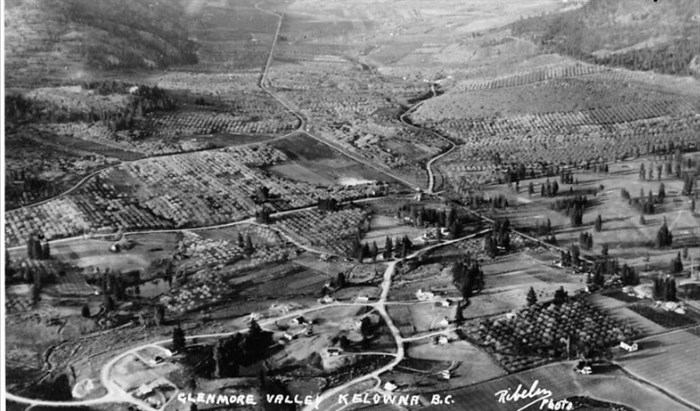
Glenmore (Dry) Valley in the 1920s.
Image Credit: FACEBOOK/Old Kelowna
Glenrosa
Originally named Glencoe by brothers Curtis and Louis David Hitchner who came from Kansas and got into real estate, logging and the sawmill business. Postal authorities objected to the name Glencoe because it was in use elsewhere so they changed it to Glenrosa.
Grindrod
Named by CPR officials after Edmund Holden Grindrod, the first CPR telegraph inspector in B.C., from 1886-1910, when the first telegraph lines in the Okanagan and the Kootenays were installed. He later took up farming south of Kamloops.
Hydraulic Creek
Early settlers got water from this creek using a hydraulic ram.
Inkaneep Creek
Since it runs into the head of Osoyoos Lake it was named Inkaneep, which means “at the head of the lake” or “creek which loses itself in the lake.”
READ MORE: Most Central Okanagan communities named after respected citizens, but not Joe Rich
Kalamalka Lake
Named after a well-known Indigenous man who lived near the lake. It was known as Long Lake when the historical report was published in 1948 but also passed some time as Woods Lake after Thomas Woods who pre-empted land at the south end of the lake in 1871. It was also once known as Chelootsoos Lake, meaning “long lake cut in middle.”
Kaleden
James Ritchie of Summerland laid out a townsite there in 1909 and offered a prize of a town lot for the best name proposed for it. Rev. Walter Russell, a vising Baptist evangelist won. It’s a combination of Kal, from the Greek meaning beautiful, and Eden, the biblical orchard.
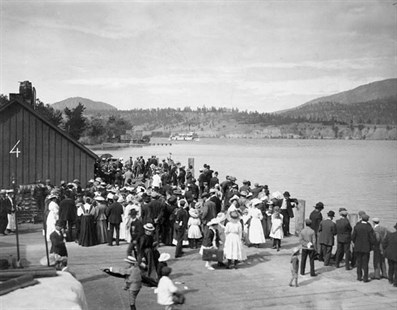
The crowd waiting on the Kelowna wharf as one of the paddlewheelers comes around the point circa 1909.
Image Credit: Submitted/Old Kelowna - from delcamp.net auction site.
Kelowna
Means ‘grizzly bear’ but had nothing to do with grizzlies. It is the story of Augustus Gillard’s nickname. He was a "husky, hairy Frenchman" who pre-empted land there in 1862 and lived in a primitive hut that was partly underground. “One day some passing Indians saw him emerge from it like a bear from its den. ‘Kimach touche, kimach touche’ they said to each other, meaning ‘brown bear’ or ‘bear face.” This became Gillard’s nickname." When the embryo city began, in 1892, the few white residents thought this name too awkward and chose, instead, another native bear name, that of the grizzly bear, or Kelowna. The post office opened in 1893 and the City of Kelowna was incorporated on May 4, 1905. The Indian name for the Kelowna area was Nor-kwa-stin, meaning hard black rock that was used for sharpening flints. The fur-traders called it L’Anse au Sable, meaning Sandy Cove.
Keremeos
The word means ‘wind channel in the mountains’ or ‘beautiful stream crossing the flats.’ A Hudson’s Bay post was established there in 1860 when Fort Okanagan on the Columbia River was closed.
Knox Mountain
Named after Arthur B. Knox who ranched at the foot of the mountain.
Lavington
Named by Sir James Buchanan after Lavington Park in England. Buchanan bought land there in the early 1900s.
Lumby
Farmer Moses Lumby settled in the area in 1870. He had mined in the Cariboo, farmed near Monte Creek and later became a justice of the peace and vice-president of the Shuswap and Okanagan Railway. He was the government agent in Vernon from 1891-93. The post office was originally named White Valley when it opened in 1889 but was changed to Lumby in 1894.

Lumby
Image Credit: Submitted/Village of Lumby
Mabel Lake
Named after Mabel Hope Charles, the eldest child of William Charles who was the Hudson’s Bay manager in Fort Kamloops until 1874. Mabel married David MacEwen Eberts who became a B.C. Court of Appeal judge.
Mara Lake
Named after John Andrew Mara, an Overlander in 1862 who had a store at Seymour on Shuswap Lake in 1865 before moving on to Kamloops where he was a merchant, miller, steamship operator and promotor of the Shuswap and Okanagan Railway that ran from Sicamous to Okanagan Lake. He was an MLA and served as Speaker of the House from 1883-86.
Mission Creek
This the largest creek flowing into Okanagan Lake. It was named after the Okanagan Mission established by Father Pandosy. The creek was originally known by First Nation people as N’wha-kwi-sen, meaning ‘smoothing stones. Later it became Riviere de l’Anse au Sable then Sandy Cove River.
Myra Canyon
Named after Myra Newman, daughter of a track-laying foreman during construction of the Kettle Valley Railway.
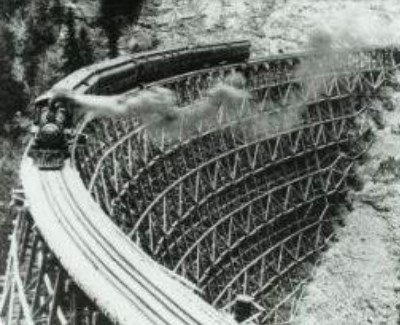
Kettle Valley Railroad through Myra Canyon.
Image Credit: FACEBOOK/Myra Canyon Restoration Society
Naramata
It was named by John Moore Robinson, the townsite owner and founder who got the name ‘from the denizens of the spirit world’ of the American Spiritualistic Church. Medium Mrs. J. M. Gillespie, apparently, communed with a First Nations man named Big Moose who dearly loved his wife, Narramattah and said she was the ‘Smile of Manitou.’ “It struck me that this would be a good name for our village, which I thought of calling Brighton Beach. We therefore cut out the unnecessary letters and called the town Naramata,” Robinson is quoted as saying. Later it was speculated that Mrs. Gillespie unconsciously took the name from the Australian aboriginal term nara matta, meaning “place of water.” Her first husband had lived in Australia. Naramata had also been known as East Summerland and a ferry ran there from Summerland in 1907.
Okanagan
Various explanations have been given for the origin of the name. One is that it means ‘rendezvous’ and was applied to the head of the river at Osoyoos Lake where Indians from B.C. and Washington often gathered for an annual potlatch. Another version is that it means ‘big head’ and is the name of a people who had exceptional skill and valor – a chosen people. The word has been spelled in 46 different ways. Lewis and Clark, in 1805, spelled it Otchen-aukane. David Thompson, in 1811, spelled it Teekanoggin, Oachenawaw-gan and Ookanawgan. In the transfer from the Pacific Fur Company to the North West Company in 1813 it was Okunaakan.
Okanagan Falls
Originally known as Dogtown, as was Skaha Lake.
READ MORE: How a South Okanagan town got its name from a waterfall that no longer exists
O’Keefe Ranch
Named after Cornelius O’Keefe, the first postmaster at Okanagan Post Office (near the head of the lake) and wealthy stock raiser described as “genial and kindly and respected by all.”
Olalla
Is said to be from the Chinook word, olallie, meaning berries. It refers to the June berry (Service berry or Saskatoon berry) that were plentiful there.
Oliver
Named for rugged “Honest John” Oliver who was premier of B.C. from 1918-27 when the province put in irrigation and a settlement scheme for the town, called the South Okanagan Land Project. It was incorporated as a village in 1945.

Osoyoos Lake
Image Credit: Submitted/Osoyoos.com
Osoyoos
This is derived from soo-yoos, meaning “where two lakes come together,” a “shallow crossing” or a “sheet of water divided in two by a narrow extension of land from opposite sides.” The O was added sometime later with differing versions of who added it but it was shown as Osoyoos on maps dating back to 1866. It was incorporated as a village in 1946.
Oyama
It was named after Prince Iwao Oyama, the Japanese commander-in-chief in the Russo-Japanese War of 1904.
Peachland
It was founded and named for its horticulture by John Moore Robinson who promoted a land subdivision and an irrigation system in 1897. It had previously been known as Camp Hewitt, a mining camp named after Gus Hewitt, a prospector and logger in the early 1890’s. The post office opened in 1898 and the town was incorporated as the District of Peachland in 1909.
Penticton
This name is from the First Nations Pente-hik-ton, meaning “ever” or “forever” which refers to the constant steady flow of the Okanagan River out of Okanagan Lake. It was incorporated in 1909.
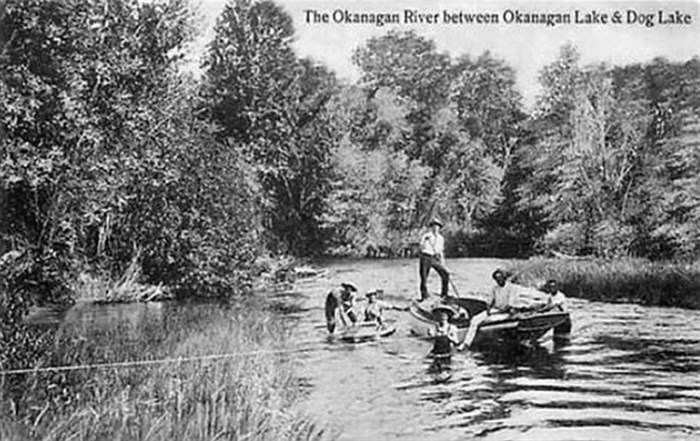
Early rafters on the Okanagan River between Okanagan Lake and Dog Lake in the 1890s.
Image Credit: Submitted/Old Kelowna
Powers Creek
It was called Spil-kuk-a-nilh by First Nations, meaning “Eagle Nest Creek.” It was later referred to as Riviere Creuse (Deep) in 1867 and Deep River on an 1871 map. It was renamed Powers Creek after William Powers who pre-empted land in the area in 1890 but later abandoned it.
Rutland
Named after John “Hope” Rutland who arrived from Australia in the 1890s and grew wheat there.
Shannon Lake
This was named after Shannon Marshall who settled the area in the 1890s. He was an “able horse-breaker and trainer, known as Professor.”
Shingle Creek
This Penticton Creek was originally called Riviere aux Serpens on the first European maps, then Beaver Creek. Shingles Creek came from the fact that First Nations and Europeans cut shingles from the cedar along the creek.
Shuswap River
This was from the Shuswap Indians who controlled the Fraser River Valley from Lillooet to Alexandria and eastward to the Rocky Mountains. It was known earlier as Spallumcheen, meaning “flat mouth” or “meadow flat.” It was changed to Shuswap officially in 1901.
Similkameen River
The original name was Similkameugh. According to the 1948 report, the meaning is unknown. The spelling change was by white settlers to force the same “phonetic groove” as Tulameen.
Skaha Lake
It was named Lac du Chien on an 1867 map and later became Dog Lake before being officially recorded as Skaha Lake in 1930. Okanagan Indians say skaha was not their word for dog, which is actually chokowapee and skaha actually means horse.
READ MORE: How a South Okanagan town got its name from a waterfall that no longer exists
Spallumcheen
This is derived from the Shuswap name spil-a-mi-shine, meaning “flat mouth” or spal-lum-shin, meaning “meadow flat.” Several spellings of the word have been recorded with the current spelling being officially adopted in 1908. It was incorporated as a township on July 21, 1892, the first community in the Okanagan to be incorporated. Vernon followed suit on Dec. 30, 1892.
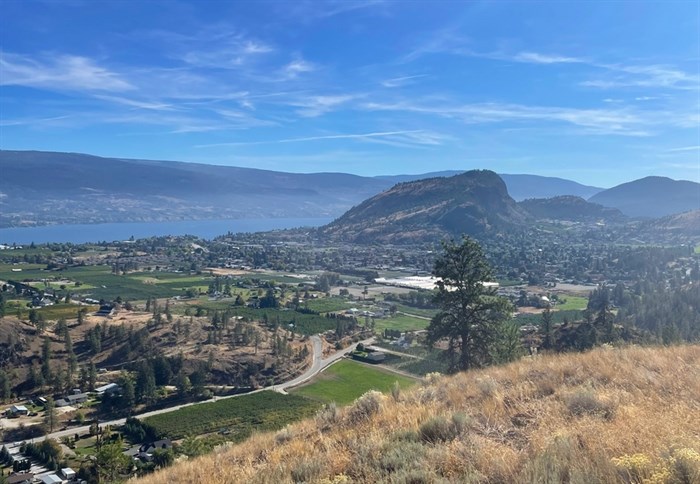
Summerland
Image Credit: Submitted/District of Summerland
Summerland
Also named by John Moore Robinson who promoted land subdivision and irrigation. It was so named because of its climate. It was incorporated in 1906.
Vaseux Lake
This lake was shown as Vasuix Lake on an 1866 map, a misspelling of the French word vaseux, meaning “muddy.” It was probably named by French-Canadian fur traders. For many years it was misspelt Vaseaux but that was corrected in 1945.
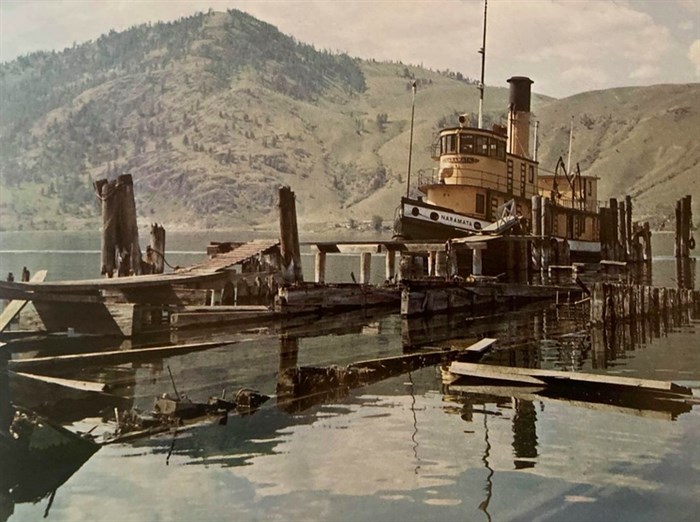
Steam tug Naramata when the tug was moored at Vernon. It pushed barges and broke ice on Okanagan Lake from 1914 to 1967.
Image Credit: Submitted/Old Kelowna - Hugo Redivo
Vernon
This was first known as what is now commonly spelled as ntelmooschin, meaning jumping off place, Johnson, from the Syilx Language House said. That was changed to Priest’s Valley after a mission was established there in 1860. It was also once called Forge Valley because of a blacksmith shop at the roadside at Price Ellison’s farm. The name was changed to Vernon in 1887 after Forbes George Vernon, chief commissioner of lands and works for B.C. He eventually became owner of the Coldstream Ranch. The name change came after it was incorporated on Dec. 30, 1892.
Winfield
It was named Alvaston by its first postmaster in 1909 after a place in England. It was changed to Winfield after Winfield Lodge, which was the home of Thomas Woods who pre-empted land there in 1871.
— This story was updated at 3:49 p.m. Monday, Jan. 9, 2023, to add comments from a First Nation language expert.
To contact a reporter for this story, email Rob Munro or call 250-808-0143 or email the editor. You can also submit photos, videos or news tips to the newsroom and be entered to win a monthly prize draw.
We welcome your comments and opinions on our stories but play nice. We won't censor or delete comments unless they contain off-topic statements or links, unnecessary vulgarity, false facts, spam or obviously fake profiles. If you have any concerns about what you see in comments, email the editor in the link above.
News from © iNFOnews, 2023